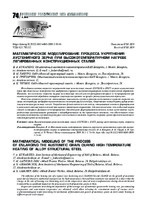| dc.contributor.author | Кукареко, В. А. | |
| dc.contributor.author | Гацуро, В. М. | |
| dc.contributor.author | Григорчик, А. Н. | |
| dc.contributor.author | Чичин, А. Н. | |
| dc.coverage.spatial | Минск | ru |
| dc.date.accessioned | 2019-10-04T11:28:56Z | |
| dc.date.available | 2019-10-04T11:28:56Z | |
| dc.date.issued | 2019 | |
| dc.identifier.citation | Математическое моделирование процесса укрупнения аустенитного зерна при высокотемпературном нагреве легированных конструкционных сталей = Mathematical modeling of the process of enlarging the austenitic grain during high-temperature heating of alloy structural steel / В. А. Кукареко [и др.] // Литье и металлургия. – 2019. – № 3. – С. 74-84. | ru |
| dc.identifier.uri | https://rep.bntu.by/handle/data/57580 | |
| dc.description.abstract | Исследовано влияние скорости нагрева типичных цементуемых сталей 15ХГН2ТА и 25ХГТ на рост аустенитного зерна при длительных изотермических выдержках в процессе высокотемпературной химико-термической обработки. Показано, что изменение скорости нагрева цементуемых сталей в температурном интервале a→g-превращения при химико-термической обработке оказывает существенное влияние на процесс роста аустенитного зерна в них. Получены уравнения регрессии, описывающие зависимость среднего размера аустенитного зерна от скорости нагрева, температуры предварительного отжига и температуры цементации, позволяющие осуществлять выбор режимов цементации различных сталей. Разработана феноменологическая модель, описывающая механизм формирования и роста аустенитных зерен в сталях при нагреве с различными скоростями. Сделано заключение, что медленный нагрев сталей в интервале фазового a→g-превращения способствует формированию комплекса мелких аустенитных зерен, разделенных высокоугловыми границами с адсорбированными на них примесными атомами, что обеспечивает повышенную устойчивость зеренной структуры к коалесценции и снижает скорость миграции границ при длительной высокотемпературной аустенизации. | ru |
| dc.language.iso | ru | ru |
| dc.publisher | БНТУ | ru |
| dc.title | Математическое моделирование процесса укрупнения аустенитного зерна при высокотемпературном нагреве легированных конструкционных сталей | ru |
| dc.title.alternative | Mathematical modeling of the process of enlarging the austenitic grain during high-temperature heating of alloy structural steel | ru |
| dc.type | Article | ru |
| dc.identifier.doi | 10.21122/1683-6065-2019-3-74-84 | |
| local.description.annotation | The influence of the heating rate of a typical case hardening steel 15KHGN2TA and 25KHGT on the growth of austenitic grain during long-term isothermal exposures at the high-temperature chemical-heat treatment was studied. It is shown that the change in the rate of heating case hardening steels in the temperature interval a→g transformations during chemical-thermal treatment has a significant impact on the process of growth of austenitic grains in them. Regression equations describing the dependence of the average size of austenitic grain on the heating rate, pre-annealing temperature and cementation temperature are obtained, which allow selecting the cementation modes of various steels. A phenomenological model describing the mechanism of formation and growth of austenitic grains in steels under heating at different speeds is developed. It is concluded that the slow heating of steels in the interval of phase a→g transformation contributes to the formation of a complex of small austenite grains separated by high angle boundaries with adsorbed on them by impurity atoms, which ensures higher resistance grain structure to coalescence and reduce the rate of migration of the boundaries during prolonged hightemperature austenization. | ru |

